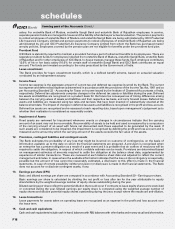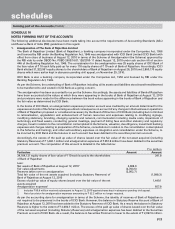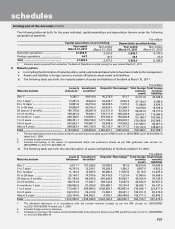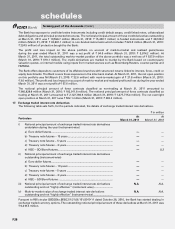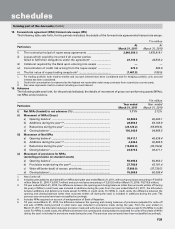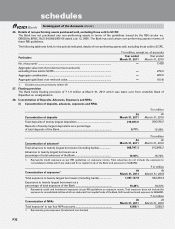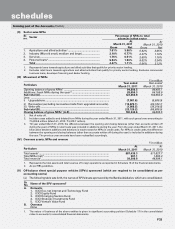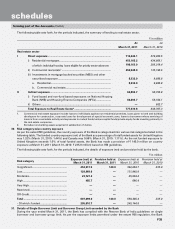ICICI Bank 2011 Annual Report Download - page 104
Download and view the complete annual report
Please find page 104 of the 2011 ICICI Bank annual report below. You can navigate through the pages in the report by either clicking on the pages listed below, or by using the keyword search tool below to find specific information within the annual report.
F26
ii) Non-performing investments in securities, other than government and other approved securities
The following table sets forth, for the periods indicated, the movement in gross non-performing investments in
securities, other than government and other approved securities.
` in million
Particulars Year ended Year ended
March 31, 2011 March 31, 2010
Opening balance ................................................................................................... 5,219.3 3,829.1
Additions during the year ..................................................................................... 1,024.5 2,626.3
Reduction during the year .................................................................................... (1,320.0) (1,236.1)
Closing balance ..................................................................................................... 4,923.8 5,219.3
Total provision held ............................................................................................... 4,302.2 3,599.8
14. Settlement date accounting for government securities
Pursuant to RBI circular DBOD.No.BP.BC.58/21.04.141/2010-11 dated November 4, 2010, the Bank has changed the
accounting for purchase and sale of government securities from trade date basis to settlement date basis with effect
from January 1, 2011. Under settlement date accounting, the purchase and sale of securities are recognised in the
books on the date of settlement. The changes in fair value of investments between trade date and settlement date are
recognised in case of purchased securities while such changes are ignored in case of securities sold. In case the Bank
had continued to follow the trade date accounting, investments portfolio at March 31, 2011 would have been lower by
` 655.2 million (net), the other assets would have been higher by ` 1,153.6 million, other liabilities would have been
higher by ` 500.2 million and the impact on the profit and loss account would have been ` Nil.
15. CBLO transactions
Collateralised Borrowing and Lending Obligation (CBLO) is a discounted money market instrument, developed by The
Clearing Corporation of India Limited (CCIL) and approved by RBI which involves secured borrowings and lending
transactions. At March 31, 2011, the Bank had outstanding borrowings amounting to Nil (March 31, 2010: Nil) and
outstanding lending of ` 1,999.6 million (March 31, 2010: Nil) in the form of CBLO. The amortised book value of securities
given as collateral by the Bank to CCIL for availing the CBLO facility was ` 51,841.1 million at March 31, 2011 (March 31,
2010: ` 44,699.4 million).
16. Derivatives
ICICI Bank is a major participant in the financial derivatives market. The Bank deals in derivatives for balance sheet
management and market making purposes whereby the Bank offers derivative products to its customers, enabling them
to hedge their risks.
Dealing in derivatives is carried out by identified groups in the treasury of the Bank based on the purpose of the transaction.
Derivative transactions are entered into by the treasury front office. Treasury middle office conducts an independent
check of the transactions entered into by the front office and also undertakes activities such as confirmation, settlement,
accounting, risk monitoring and reporting and ensures compliance with various internal and regulatory guidelines.
The market making and the proprietary trading activities in derivatives are governed by the Investment Policy and the
Derivative Policy of the Bank, which lay down the position limits, value at risk limits, stop loss limits as well as other risk
limits. The Risk Management Group (RMG) lays down the methodology for computation and monitoring of risk. The Risk
Committee of the Board (RCB) reviews the Bank’s risk management policies in relation to various risks including Credit
and recovery policy, Investment Policy, Derivative Policy, ALM Policy and Operational Risk Management Policy. The RCB
comprises independent directors and the Managing Director and CEO.
The Bank measures and monitors risk of its derivatives portfolio using such risk metrics as Value at Risk (VAR), stop
loss limits and relevant greeks for options. Risk reporting on derivatives forms an integral part of the management
information system.
The use of derivatives for hedging purposes is governed by the hedge policy approved by Asset Liability Management
Committee (ALCO). Subject to prevailing RBI guidelines, the Bank deals in derivatives for hedging fixed rate, floating
rate or foreign currency assets/liabilities. Transactions for hedging and market making purposes are recorded separately.
For hedge transactions, the Bank identifies the hedged item (asset or liability) at the inception of the hedge itself. The
effectiveness is assessed at the time of inception of the hedge and periodically thereafter.
Hedge derivative transactions are accounted for pursuant to the principles of hedge accounting. Derivatives for market
making purpose are marked to market and the resulting gain/loss is recorded in the profit and loss account. The premium
on option contracts is accounted for as per Foreign Exchange Dealers Association of India (FEDAI) guideline.
Derivative transactions are covered under International Swaps and Derivatives Association (ISDA) master agreements
with the respective counter parties. The exposure on account of derivative transactions is computed as per RBI guidelines
and is marked against the credit limits approved for the respective counter-parties.
forming part of the Accounts (Contd.)
schedules


